Chevrolet Equinox 2017 Owner's Manual
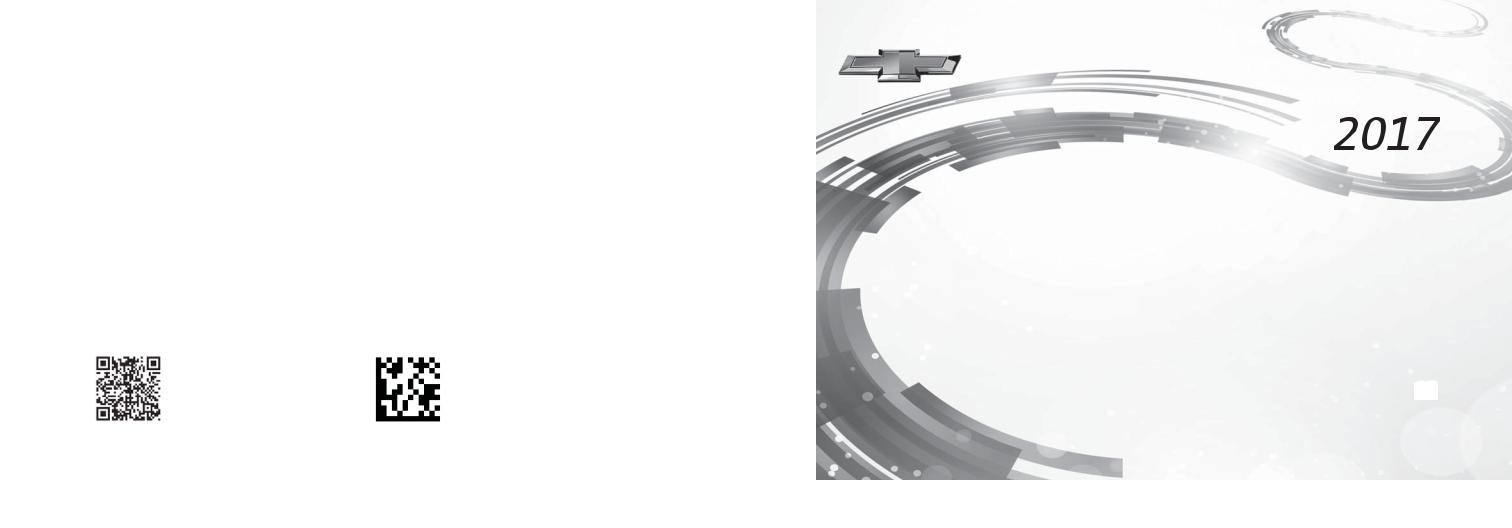
Equinox Owner’s Manual
chevrolet.com (U.S.) chevrolet.gm.ca (Canada)

Contents
Introduction . . . . . . . . . . . . . . . . . . . . . . 2
In Brief . . . . . . . . . . . . . . . . . . . . . . . . . . . 5
Keys, Doors, and Windows . . . . . 24
Seats and Restraints . . . . . . . . . . . 44
Storage . . . . . . . . . . . . . . . . . . . . . . . . . 91
Instruments and Controls . . . . . . . 95
Lighting . . . . . . . . . . . . . . . . . . . . . . . 133
Infotainment System . . . . . . . . . . 139
Climate Controls . . . . . . . . . . . . . . 140
Driving and Operating . . . . . . . . . 147
Vehicle Care . . . . . . . . . . . . . . . . . . 200
Service and Maintenance . . . . . 275
Technical Data . . . . . . . . . . . . . . . . 288
Customer Information . . . . . . . . . 292
Reporting Safety Defects . . . . . . 303
OnStar . . . . . . . . . . . . . . . . . . . . . . . . 306
Index . . . . . . . . . . . . . . . . . . . . 316

2Introduction
Introduction
The names, logos, emblems, slogans, vehicle model names, and vehicle body designs appearing in this manual including, but not limited to, GM, the GM logo, CHEVROLET, the CHEVROLET Emblem, and EQUINOX are trademarks and/or service marks of General Motors LLC, its subsidiaries, affiliates,
or licensors.
For vehicles first sold in Canada, substitute the name “General Motors of Canada Company” for Chevrolet Motor Division wherever it appears in this manual.
This manual describes features that may or may not be on the vehicle because of optional equipment that was not purchased on the vehicle, model variants, country specifications, features/applications that may not be available in your region, or changes subsequent to the printing of this owner manual.
Refer to the purchase documentation relating to your specific vehicle to confirm the features.
Keep this manual in the vehicle for quick reference.
Canadian Vehicle Owners
A French language manual can be obtained from your dealer, at www.helminc.com, or from:
Propriétaires Canadiens
On peut obtenir un exemplaire de ce guide en français auprès du concessionnaire ou à l'adresse suivante:
Helm, Incorporated
Attention: Customer Service
47911 Halyard Drive
Plymouth, MI 48170
USA
Using this Manual
To quickly locate information about the vehicle, use the Index in the back of the manual. It is an alphabetical list of what is in the manual and the page number where it can be found.
Litho in U.S.A. |
© 2016 General Motors LLC. All Rights Reserved. |
Part No. 23233623 A First Printing |

Introduction 3
Danger, Warning, and
Caution
Warning messages found on vehicle labels and in this manual describe hazards and what to do to avoid or reduce them.
{Danger
Danger indicates a hazard with a high level of risk which will result in serious injury or death.
{Warning
Warning indicates a hazard that could result in injury or death.
Caution
Caution indicates a hazard that could result in property or vehicle damage.
A circle with a slash through it is a safety symbol which means “Do Not,” “Do not do this,” or “Do not let this happen.”
Symbols
The vehicle has components and labels that use symbols instead of text. Symbols are shown along with the text describing the operation or information relating to a specific component, control, message, gauge, or indicator.
M : Shown when the owner manual has additional instructions or information.
* : Shown when the service manual has additional instructions or information.
0 : Shown when there is more information on another page — “see page.”
Vehicle Symbol Chart
Here are some additional symbols that may be found on the vehicle and what they mean. For more information on the symbol, refer to the Index.
9 : Airbag Readiness Light
# : Air Conditioning
! : Antilock Brake System (ABS) $ : Brake System Warning Light
" : Charging System
I : Cruise Control
` : Do Not Puncture
^ : Do Not Service
B : Engine Coolant Temperature
O : Exterior Lamps
_ : Flame/Fire Prohibited
# : Fog Lamps
. : Fuel Gauge
+ : Fuses
3 : Headlamp High/Low-Beam Changer
j : LATCH System Child Restraints

4Introduction
* : Malfunction Indicator Lamp
: : Oil Pressure
Q : OnStar®
} : Power
/ : Remote Vehicle Start
> : Safety Belt Reminders
% : Steering Wheel Controls
7 : Tire Pressure Monitor
d : Traction Control/StabiliTrak®
a : Under Pressure
M : Windshield Washer Fluid

In Brief |
5 |
|
|
In Brief
Instrument Panel
Instrument Panel . . . . . . . . . . . . . . . . 6
Initial Drive Information
Initial Drive Information . . . . . . . . . . 7
Remote Keyless Entry (RKE)
System . . . . . . . . . . . . . . . . . . . . . . . . 7
Remote Vehicle Start . . . . . . . . . . . 8
Door Locks . . . . . . . . . . . . . . . . . . . . . 9
Liftgate . . . . . . . . . . . . . . . . . . . . . . . . . . 9
Windows . . . . . . . . . . . . . . . . . . . . . . . 10
Seat Adjustment . . . . . . . . . . . . . . . 10
Memory Features . . . . . . . . . . . . . . 12
Heated Seats . . . . . . . . . . . . . . . . . . 12
Head Restraint Adjustment . . . . 12
Safety Belts . . . . . . . . . . . . . . . . . . . . 13
Passenger Sensing System . . . 13
Mirror Adjustment . . . . . . . . . . . . . . 13
Steering Wheel Adjustment . . . . 14
Interior Lighting . . . . . . . . . . . . . . . . 14
Exterior Lighting . . . . . . . . . . . . . . . 15
Windshield Wiper/Washer . . . . . . 15
Climate Controls . . . . . . . . . . . . . . . 16
Transmission . . . . . . . . . . . . . . . . . . 17
Parking Brake . . . . . . . . . . . . . . . . . 18
Vehicle Features
Infotainment System . . . . . . . . . . . 18
Steering Wheel Controls . . . . . . . 18
Cruise Control . . . . . . . . . . . . . . . . . 19
Driver Information
Center (DIC) . . . . . . . . . . . . . . . . . 19
Forward Collision Alert (FCA)
System . . . . . . . . . . . . . . . . . . . . . . . 19
Lane Departure
Warning (LDW) . . . . . . . . . . . . . . . 20
Side Blind Zone
Alert (SBZA) . . . . . . . . . . . . . . . . . . 20
Rear Vision Camera (RVC) . . . . 20
Rear Cross Traffic Alert (RCTA)
System . . . . . . . . . . . . . . . . . . . . . . . 20
Parking Assist . . . . . . . . . . . . . . . . . 20
Power Outlets . . . . . . . . . . . . . . . . . 20
Sunroof . . . . . . . . . . . . . . . . . . . . . . . . 21
Performance and Maintenance
Traction Control/Electronic Stability Control . . . . . . . . . . . . . . 21
Tire Pressure Monitor . . . . . . . . . . 22 Fuel . . . . . . . . . . . . . . . . . . . . . . . . . . . 22 E85 or FlexFuel . . . . . . . . . . . . . . . . 22 Engine Oil Life System . . . . . . . . 23 Driving for Better Fuel
Economy . . . . . . . . . . . . . . . . . . . . . 23 Roadside Assistance
Program . . . . . . . . . . . . . . . . . . . . . . 23
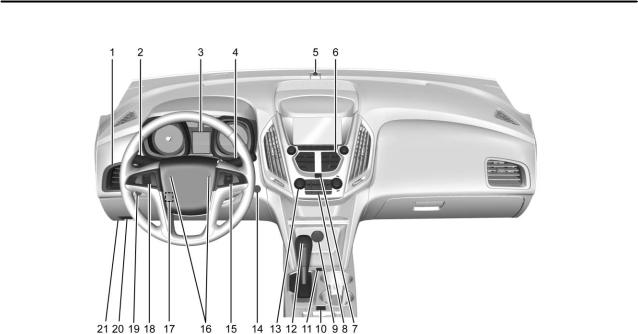
6In Brief
Instrument Panel

In Brief |
7 |
|
|
1. |
Air Vents 0 145. |
12. |
Shift Lever. See Automatic |
2. |
Turn Signal Lever. See Turn |
|
Transmission 0 170. |
|
Climate Control Systems 0 140 |
||
|
and Lane-Change |
13. |
|
|
Signals 0 135. |
|
(If Equipped). |
|
Exterior Lamp Controls 0 133. |
|
Automatic Climate Control |
|
Fog Lamps 0 135 (If |
|
System 0 142 (If Equipped). |
|
|
Ignition Positions 0 163. |
|
|
Equipped). |
14. |
|
3. |
Instrument Cluster 0 101. |
15. |
Steering Wheel Controls 0 96. |
4. |
Windshield Wiper/Washer 0 96. |
16. |
Horn 0 96. |
|
Rear Window Wiper/ |
17. |
Steering Wheel |
|
Washer 0 98. |
|
Adjustment 0 96. |
5. |
Light Sensor. See Automatic |
18. |
Cruise Control 0 177. |
|
Headlamp System 0 134. |
19. |
Instrument Panel Illumination |
|
|
||
6. |
Infotainment 0 139. |
|
Control 0 136. |
7. |
Hazard Warning |
20. |
Hood Release (Out of View). |
|
Flashers 0 135. |
|
See Hood 0 203. |
8. |
Driver Information Center |
21. |
Data Link Connector (DLC) |
|
Buttons (If Equipped). See |
|
(Out of View). See Malfunction |
|
Driver Information Center |
|
Indicator Lamp (Check Engine |
|
(DIC) 0 113. |
|
Light) 0 106. |
9. |
Power Outlets 0 100. |
|
|
10.Traction Control/Electronic Stability Control 0 175.
11.eco Button (If Equipped). See
Fuel Economy Mode 0 172.
Initial Drive
Information
This section provides a brief overview about some of the important features that may or may not be on your specific vehicle.
For more detailed information, refer to each of the features which can be found later in this owner manual.
Remote Keyless Entry
(RKE) System
The Remote Keyless Entry (RKE) transmitter may work up to
60 m (197 ft) away from the vehicle.

8In Brief
With Remote Start and Power
Liftgate Shown
Press this button to extend the key. The key can be used for the ignition and all locks.
K : Press to unlock the driver door or all doors.
For vehicles with the manual liftgate, press K twice within
five seconds to unlock the liftgate.
Q : Press to lock all doors.
Lock and unlock feedback can be personalized.
Y: If equipped with the power liftgate, press and hold until the liftgate begins to move.
7 : Press and release to initiate vehicle locator. Press and hold for at least three seconds to sound the
panic alarm. Press 7 again to cancel the panic alarm.
/ : Press Q and release and then immediately press and hold / for at least four seconds to start the engine from outside the vehicle.
See Keys 0 24 and Remote Keyless Entry (RKE) System Operation 0 26.
Remote Vehicle Start
If equipped, the engine can be started from outside of the vehicle.
Starting the Vehicle
1.Press and release Q on the RKE transmitter.
2.Immediately press and hold / for at least four seconds or until the turn signal lamps flash.
Start the vehicle normally after entering.
When the vehicle starts, the parking lamps will turn on.
Remote start can be extended.
Canceling a Remote Start
To cancel a remote start, do one of the following:
.Press and hold / until the parking lamps turn off.
.Turn on the hazard warning flashers.
. Turn the vehicle on and then off.
See Remote Vehicle Start 0 28.

In Brief |
9 |
|
|
Door Locks
To lock or unlock the vehicle from the outside, press Q or K on the Remote Keyless Entry (RKE) transmitter.
Q : Press to lock the doors.
K : Press to unlock the doors.
See Door Locks 0 30.
To manually unlock a door from inside the vehicle, pull once on the door handle to unlock it, and a second time to open it.
Liftgate
Manual Liftgate Operation
Unlock the vehicle before opening the liftgate.
To open the liftgate, press the touch pad under the liftgate handle and lift up.
Do not press the touch pad while closing the liftgate. This may cause the liftgate to be unlatched.
Power Liftgate Operation
On vehicles with a power liftgate, the vehicle must be in P (Park) to use the power feature. The taillamps flash when the power liftgate moves.
Choose the power liftgate mode by turning the dial on the switch to either the 3/4 or MAX position.
Press 8to open or close the liftgate.
See Liftgate 0 32.

10 In Brief
Windows |
Seat Adjustment |
Eight-Way Power Seat |
|
Four-Way Power Seat |
|
Press the front of the switch to lower the window. Pull the switch up to raise it.
See Power Windows 0 41.
1.Seat Position Handle
2.Height Adjustment Control
To adjust the seat, if equipped:
.Move the seat forward or rearward using the handle under the front of the seat cushion (1). See Seat Adjustment 0 46.
.Raise or lower the entire seat by moving the control (2) up
or down.
See Power Seat Adjustment 0 46.
To adjust a power seat, if equipped:
.Move the seat forward or rearward by sliding the control forward or rearward.
.Raise or lower the front part of the seat cushion by moving the front of the control up or down.
.Raise or lower the entire seat by moving the rear of the control up or down.
See Power Seat Adjustment 0 46.

In Brief |
11 |
|
|
Lumbar Adjustment
Eight-Way Power Seat Shown,
Four-Way Similar
If available, press and hold the front or rear of the switch to increase or decrease lumbar support. Release the switch when the seatback reaches the desired level of lumbar support.
See Lumbar Adjustment 0 47.
Reclining Seatbacks
Manual Reclining Seatbacks
To recline a manual seatback:
1.Lift the lever.
2.Move the seatback to the desired position, and then release the lever to lock the seatback in place.
3.Push and pull on the seatback to make sure it is locked.
To return the seatback to the upright position:
1.Lift the lever fully without applying pressure to the seatback, and the seatback will return to the upright position.
2.Push and pull on the seatback to make sure it is locked.
Power Reclining Seatbacks
To adjust a power seatback, if available:
.Tilt the top of the control rearward to recline.
.Tilt the top of the control forward to raise.

12 In Brief
See Reclining Seatbacks 0 48.
Memory Features
If available, the 1, 2, and MEM (Memory) buttons on the outboard side of the driver seat are used to manually store and recall the driver seat and outside mirror positions. These manually stored positions are referred to as Button Memory positions.
The vehicle will also automatically store driver seat and outside mirror positions to the current driver Remote Keyless Entry (RKE) transmitter when the ignition is
turned off. These automatically stored positions are referred to as RKE Memory positions.
See Memory Seats 0 49 and
Vehicle Personalization 0 123.
Heated Seats
Uplevel Climate Control System
Shown, Base Similar
If available, the buttons are near the climate controls. To operate, the ignition must be in ON/RUN.
Press z or J to heat the driver or passenger seat cushion and seatback.
Indicator lights on the button show the temperature setting.
See Heated Front Seats 0 51.
Head Restraint
Adjustment
Do not drive until the head restraints for all occupants are installed and adjusted properly.
To achieve a comfortable seating position, change the seatback recline angle as little as necessary while keeping the seat and the head restraint height in the proper position.
See Head Restraints 0 45 and Seat
Adjustment 0 46.
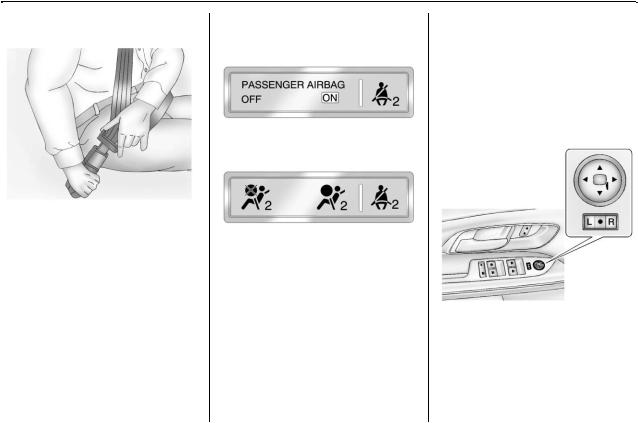
In Brief |
13 |
|
|
Safety Belts |
Passenger Sensing |
|
System |
Refer to the following sections for important information on how to use safety belts properly:
.Safety Belts 0 53.
.How to Wear Safety Belts Properly 0 54.
.Lap-Shoulder Belt 0 55.
.Lower Anchors and Tethers for Children (LATCH System) 0 79.
United States
Canada and Mexico
The passenger sensing system will turn off the front outboard passenger frontal airbag under certain conditions. No other airbag is affected by the passenger sensing system. See Passenger Sensing System 0 66.
The passenger airbag status indicator will be visible on the overhead console when the vehicle is started. See Passenger Airbag Status Indicator 0 104.
Mirror Adjustment
Exterior
To adjust the mirrors:
1.Move the selector switch to L (Left) or R (Right) to choose the driver or passenger mirror.
2.Press the arrows on the control pad to move each mirror in the desired direction.

14 In Brief
3.Return the selector switch to the middle position.
See Power Mirrors 0 39.
Interior
Adjustment
Adjust the rearview mirror to clearly view the area behind the vehicle.
Manual Rearview Mirror
For vehicles with a manual rearview mirror, push the tab forward for daytime use and pull it rearward for nighttime use to avoid the glare of the headlamps from behind. See
Manual Rearview Mirror 0 40.
Automatic Dimming Rearview
Mirror
Vehicles with an automatic dimming inside rearview mirror automatically reduce the glare of the headlamps from behind. The dimming feature comes on when the vehicle is started. See Automatic Dimming Rearview Mirror 0 40.
Steering Wheel
Adjustment
To adjust the steering wheel:
1.Pull the lever down.
2.Move the steering wheel up or down.
3.Pull or push the steering wheel closer or away from you.
4.Pull the lever up to lock the steering wheel in place.
Do not adjust the steering wheel while driving.
Interior Lighting
Reading Lamps
These lamps are located on the overhead console. These lamps come on automatically when any door is opened.
For manual operation, press the button next to each lamp to turn it on or off.
Dome Lamps
There are front and rear dome lamps.
The dome lamp controls are located in the overhead console. To change the settings, press the following:
* : Turns the lamp off, even when a door is open.
1 : The lamps come on automatically when a door is opened.
+ : Turns the dome lamps on.
The dome lamps can also be turned on and off by pressing the buttons next to the lamps.
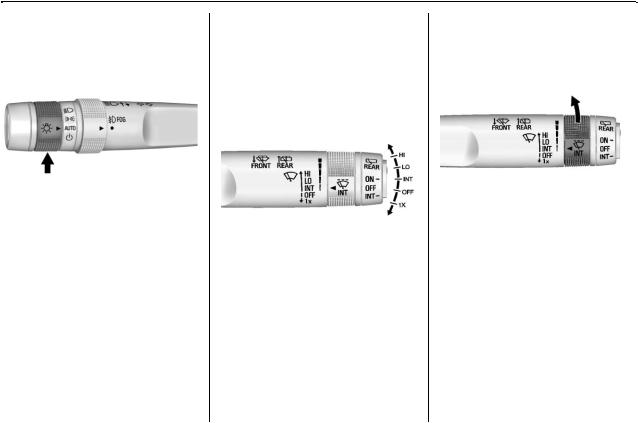
In Brief |
15 |
|
|
For more information on interior lighting, See Instrument Panel Illumination Control 0 136.
Exterior Lighting
See:
.Exterior Lamp Controls 0 133.
.Daytime Running Lamps (DRL) 0 134.
.Fog Lamps 0 135.
Windshield Wiper/Washer
The exterior lamp control is on the turn signal lever.
O : Briefly turn to this position to turn the automatic light control off or on again.
AUTO : Turns the exterior lamps on and off automatically depending on the exterior light.
; : Turns on the parking lamps including all lamps, except the headlamps.
5 : Turns on the headlamps, together with the parking lamps and instrument panel lights.
The windshield wiper/washer lever is located on the right side of the steering column. With the ignition in ACC/ACCESSORY or ON/RUN/ START, move the windshield wiper lever to select the wiper speed.
HI : Use for fast wipes.
LO : Use for slow wipes.
INT : Move the lever up to INT for intermittent wipes, then turn the 3INT band up for more frequent wipes or down for less frequent wipes.
OFF : Use to turn the wipers off.
1X : For a single wipe, briefly move the wiper lever down. For several wipes, hold the wiper lever down.
n L FRONT : Pull the windshield wiper lever toward you to spray windshield washer fluid and activate the wipers.
Rear Window Wiper/Washer
The rear wiper controls are on the end of the windshield wiper lever.

16 In Brief
ON : Press the upper portion of the button for continuous rear window wipes.
OFF : The rear wiper turns off when the button is returned to the middle position.
INT : Press the lower portion of the button to set a delay between wipes.
a : Push the windshield wiper lever forward to spray washer fluid on the rear window. The lever automatically returns to its original position when released.
See Windshield Wiper/Washer 0 96
and Rear Window Wiper/
Washer 0 98.
Climate Controls
The vehicle's heating, cooling, defrosting, and ventilation can be controlled with these systems.
|
Climate Control System |
||
1. |
Fan Control |
5. |
Recirculation |
2. |
Air Delivery Mode Controls |
6. |
Rear Window Defogger |
3. |
Temperature Control |
7. |
Front Defrost |
4. |
A/C (Air Conditioning) |
8. |
Outside Air |

In Brief |
17 |
|
|
Automatic Climate Control System
1.Fan Control
2.AUTO (Automatic Operation)
3.Air Delivery Mode Controls
4.Front Defrost
5.Recirculation
6.Temperature Control
7.A/C (Air Conditioning)
8.Driver and Passenger Heated Seats (If Equipped)
9.Rear Window Defogger
10. Power
See Climate Control Systems 0 140 (If Equipped) or Automatic Climate Control System 0 142 (If Equipped).
Transmission
Electronic Range Select
(ERS) Mode
ERS or manual mode allows for the selection of the range of gear positions. Use this mode when driving downhill or towing a trailer to limit the top gear and vehicle speed.
To use this feature:
1.Move the shift lever to M (Manual Mode).
2.Press the plus/minus button on the shift lever to increase or decrease the gear range available.
See Manual Mode 0 172.

18 In Brief
Fuel Economy Mode
Vehicles with a 2.4L engine have a Fuel Economy Mode. When engaged, Fuel Economy Mode can improve the vehicle's fuel economy.
Press the eco (economy) button to turn this feature on or off. The eco light in the instrument cluster will come on when engaged, and a Driver Information Center (DIC) message displays. See Fuel Economy Mode 0 172.
Parking Brake
To set the parking brake, hold the regular brake pedal down, then push the parking brake pedal down.
If the ignition is on, the brake system warning light will come on. See Brake System Warning
Light 0 108.
To release the parking brake, hold the regular brake pedal down, then push down momentarily on the parking brake pedal until you feel the pedal release. Slowly pull your foot up off the parking brake pedal.
See Parking Brake 0 174.
Vehicle Features
Infotainment System
See the infotainment manual for information on the radio, audio players, phone, navigation system, and voice or speech recognition. It also includes information on settings.
Steering Wheel Controls
The infotainment system can be operated by using the steering wheel controls. See "Steering Wheel Controls" in the infotainment manual.

In Brief |
19 |
|
|
Cruise Control
o : Press to turn the cruise control system on and off.
n : Press to disengage cruise control without erasing the set speed from memory.
RES/+ : If there is a set speed in memory, move the thumbwheel up briefly to resume to that speed or hold upward to accelerate. If cruise control is already active, use to increase vehicle speed.
SET/− : Move the thumbwheel down briefly to set the speed and activate cruise control. If cruise control is already active, use to decrease speed.
See Cruise Control 0 177.
Driver Information
Center (DIC)
The DIC display is in the center of the instrument cluster. It shows the status of many vehicle systems.
The DIC buttons are below the climate control system.
MENU : Press this button to get to the Trip/Fuel Menu and the Vehicle Information Menu.
Q or R : Use these buttons to scroll through the items in each menu.
A small marker will move along the page as you scroll through the items. This shows where each page is in the menu.
SET/CLR : Use this button to set or clear the menu item when it is displayed.
See Driver Information Center (DIC) 0 113.
Forward Collision Alert
(FCA) System
If equipped, FCA may help avoid or reduce the harm caused by front-end crashes. FCA provides a
green indicator, V, when a vehicle is detected ahead. When approaching a vehicle ahead too quickly, FCA provides a red flashing alert and rapidly beeps. This alert stays lit if you follow a vehicle much too closely.
See Forward Collision Alert (FCA)
System 0 183.

20 In Brief
Lane Departure
Warning (LDW)
If equipped, LDW may help avoid unintentional lane departures at speeds of 56 km/h (35 mph) or greater. LDW uses a camera sensor to detect the lane markings. The
LDW light, @, is green if a lane marking is detected. If the vehicle departs the lane without using a turn signal in that direction, the light will change to amber and flash. In addition, beeps will sound.
See Lane Departure Warning (LDW) 0 187.
Side Blind Zone
Alert (SBZA)
If equipped, SBZA will detect moving vehicles in the next lane over in the vehicle's side blind zone area. When this happens, the SBZA display will light up in the corresponding outside side mirror and will flash if the turn signal is on.
See Side Blind Zone Alert (SBZA) 0 185.
Rear Vision
Camera (RVC)
If equipped, RVC displays a view of the area behind the vehicle, on the infotainment system display, when the vehicle is shifted into
R (Reverse).
See Rear Vision Camera (RVC) 0 180.
Rear Cross Traffic Alert
(RCTA) System
If equipped, the RCTA system uses a triangle with an arrow displayed on the RVC screen to warn of traffic behind your vehicle that may cross your vehicle's path while in
R (Reverse). In addition, beeps will sound.
See “Rear Cross Traffic Alert (RCTA)” under Rear Vision Camera (RVC) 0 180.
Parking Assist
If equipped, Rear Parking Assist (RPA) uses sensors on the rear bumper to assist with parking and
avoiding objects while in
R (Reverse). It operates at speeds less than 8 km/h (5 mph) and uses audible beeps to provide distance and system information.
Keep the sensors on the vehicle's rear bumper clean to ensure proper operation.
See Parking Assist 0 182.
Power Outlets
The accessory power outlets can be used to connect electrical equipment, such as a cell phone or MP3 player.
There are four accessory power outlets: inside the open storage area in front of the shift lever, inside the center console storage, on the rear of the center console storage, and in the rear cargo compartment.
To use the outlets, remove the cover and close when not in use.
See Power Outlets 0 100.

In Brief |
21 |
|
|
Sunroof
If equipped, the sunroof switches are on the headliner above the rearview mirror. The ignition must be in ON/RUN or ACC/ACCESSORY, or in Retained Accessory Power (RAP) to operate the sunroof. See
Ignition Positions 0 163 and
Retained Accessory Power (RAP) 0 166.
1.Slide Switch
2.Tilt Switch
Slide Switch
Express-Open/Express-Close :
Press and release e(1) to express-open the sunroof. Press and release g(1) to express-close the sunroof.
Open/Close (Manual Mode) :
Press and hold e(1) to open the
sunroof. Press and hold g(1) to close. The sunshade automatically opens with the sunroof, but must be closed manually.
Tilt Switch
Vent : Press and hold f(2) to vent the sunroof. Press and hold g(2) to close.
Performance and
Maintenance
Traction Control/
Electronic Stability
Control
The traction control system limits wheel spin. The system is on when the vehicle is started.
The StabiliTrak system assists with directional control of the vehicle in difficult driving conditions. The system is on when the vehicle is started.
.To turn off traction control, press
and release g on the console. i illuminates and the appropriate DIC message displays. See Ride Control System Messages 0 120.
.Press and release g again to turn traction control back on.

22 In Brief
.To turn off both Traction Control and StabiliTrak, press and
hold g until g and i illuminate and the appropriate DIC message displays. See Ride Control System
Messages 0 120.
.Press g again to turn on both systems.
See Traction Control/Electronic
Stability Control 0 175.
Tire Pressure Monitor
This vehicle may have a Tire Pressure Monitor System (TPMS).
The low tire pressure warning light alerts to a significant loss in pressure of one of the vehicle's
tires. If the warning light comes on, stop as soon as possible and inflate the tires to the recommended pressure shown on the Tire and Loading Information label. See
Vehicle Load Limits 0 159. The warning light will remain on until the tire pressure is corrected.
The low tire pressure warning light may come on in cool weather when the vehicle is first started, and then turn off as the vehicle is driven. This may be an early indicator that the tire pressures are getting low and the tires need to be inflated to the proper pressure.
The TPMS does not replace normal monthly tire maintenance. Maintain the correct tire pressures.
See Tire Pressure Monitor
System 0 241.
Fuel
Regular Fuel
Use only unleaded gasoline rated 87 octane or higher in your vehicle. Do not use gasoline with an octane rating lower as it may result in vehicle damage and lower fuel economy. See Fuel 0 189.
E85 or FlexFuel
FlexFuel Possible
Certain models are compatible with E85 fuel. See Fuel 0 189.

In Brief |
23 |
|
|
Engine Oil Life System
The engine oil life system calculates engine oil life based on vehicle use and displays the CHANGE ENGINE OIL SOON message when it is time to change the engine oil and filter.
The oil life system should be reset to 100% only following an oil change.
Resetting the Oil Life System
1.Turn the ignition to ON/RUN, with the engine off.
2.Press the DIC MENU button to display the Vehicle Information menu.
3.Press either the up or down arrows to view REMAINING OIL LIFE.
4.Press the SET/CLR button until 100% is displayed.
5.Turn the key to LOCK/OFF.
Or:
1.Turn the ignition to ON/RUN with the engine off.
2.Fully press and release the accelerator pedal three times within five seconds.
See Engine Oil Life System 0 210.
Driving for Better Fuel Economy
Driving habits can affect fuel mileage. Here are some driving tips to get the best fuel economy possible.
.Avoid fast starts and accelerate smoothly.
.Brake gradually and avoid abrupt stops.
.Avoid idling the engine for long periods of time.
.When road and weather conditions are appropriate, use cruise control.
.Always follow posted speed limits or drive more slowly when conditions require.
.Keep vehicle tires properly inflated.
.Combine several trips into a single trip.
.Replace the vehicle's tires with the same TPC Spec number molded into the tire's sidewall near the size.
.Follow recommended scheduled maintenance.
Roadside Assistance
Program
U.S.: 1-800-243-8872
TTY Users (U.S. Only): 1-888-889-2438
Canada: 1-800-268-6800
New Chevrolet owners are automatically enrolled in the Roadside Assistance Program.
See Roadside Assistance
Program 0 296.

24 Keys, Doors, and Windows
Keys, Doors, and
Windows
Keys and Locks
Keys . . . . . . . . . . . . . . . . . . . . . . . . . . . 24
Remote Keyless Entry (RKE)
System . . . . . . . . . . . . . . . . . . . . . . . 26
Remote Keyless Entry (RKE)
System Operation . . . . . . . . . . . . 26
Remote Vehicle Start . . . . . . . . . . 28
Door Locks . . . . . . . . . . . . . . . . . . . . 30
Power Door Locks . . . . . . . . . . . . . 31
Delayed Locking . . . . . . . . . . . . . . . 31
Automatic Door Locks . . . . . . . . . 31
Lockout Protection . . . . . . . . . . . . . 31
Safety Locks . . . . . . . . . . . . . . . . . . . 31
Doors
Liftgate . . . . . . . . . . . . . . . . . . . . . . . . 32
Vehicle Security
Vehicle Security . . . . . . . . . . . . . . . . 36
Vehicle Alarm System . . . . . . . . . 36
Immobilizer . . . . . . . . . . . . . . . . . . . . 37
Immobilizer Operation . . . . . . . . . 38
Exterior Mirrors
Convex Mirrors . . . . . . . . . . . . . . . . 38
Power Mirrors . . . . . . . . . . . . . . . . . . 39
Heated Mirrors . . . . . . . . . . . . . . . . . 39
Reverse Tilt Mirrors . . . . . . . . . . . . 39
Interior Mirrors
Interior Rearview Mirrors . . . . . . . 40
Manual Rearview Mirror . . . . . . . . 40
Automatic Dimming Rearview
Mirror . . . . . . . . . . . . . . . . . . . . . . . . . 40
Windows
Windows . . . . . . . . . . . . . . . . . . . . . . . 40
Power Windows . . . . . . . . . . . . . . . 41
Sun Visors . . . . . . . . . . . . . . . . . . . . . 42
Roof
Sunroof . . . . . . . . . . . . . . . . . . . . . . . . 42
Keys and Locks
Keys
{Warning
Leaving children in a vehicle with the ignition key is dangerous and children or others could be seriously injured or killed. They could operate the power windows or other controls or make the vehicle move. The windows will function with the keys in the ignition, and children or others could be caught in the path of a closing window. Do not leave children in a vehicle with the ignition key.
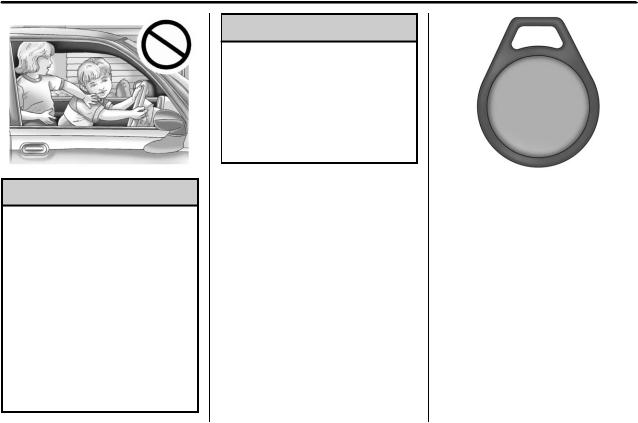
Keys, Doors, and Windows 25
{Warning
If the key is unintentionally rotated while the vehicle is running, the ignition could be moved out of the RUN position. This could be caused by heavy items hanging from the key ring, or by large or long items attached to the key ring that could be contacted by the driver or steering wheel. If the ignition moves out of the RUN position, the engine will shut off, braking and steering power assist may be
(Continued)
Warning (Continued)
impacted, and airbags may not deploy. To reduce the risk of unintentional rotation of the ignition key, do not change the way the ignition key and Remote Keyless Entry (RKE) transmitter, if equipped, are connected to the provided key rings.
The ignition key, key rings, and RKE transmitter, if equipped, are designed to work together. As a system, it reduces the risk of unintentionally moving the key out of the RUN position. If replacements or additions are required, see your dealer. Limit added items to a few essential keys or small, light items no larger than an RKE transmitter.
Interference from radio-frequency identification (RFID) tags may prevent the key from starting the vehicle. Keep RFID tags away from the key when starting the vehicle.
The key that is part of the Remote Keyless Entry (RKE) transmitter can be used for the ignition and all locks.

26 Keys, Doors, and Windows
Press the button on the RKE transmitter to extend the key. Press the button and the key blade to retract the key.
See your dealer if a new key is needed.
If it becomes difficult to turn the key, inspect the key blade for debris. Periodically clean with a brush
or pick.
If locked out of the vehicle, see
Roadside Assistance Program 0 296.
With an active OnStar subscription, an OnStar Advisor may remotely unlock the vehicle. See OnStar Overview 0 306.
Remote Keyless Entry
(RKE) System
See Radio Frequency
Statement 0 302.
If there is a decrease in the Remote Keyless Entry (RKE) operating range:
.Check the distance. The transmitter may be too far from the vehicle.
.Check the location. Other vehicles or objects may be blocking the signal.
.Check the transmitter's battery. See “Battery Replacement” later in this section.
.If the transmitter is still not working correctly, see your dealer or a qualified technician for service.
Remote Keyless Entry
(RKE) System Operation
The RKE transmitter may work up to 60 m (197 ft) away from the vehicle.
Other conditions can affect the performance of the transmitter. See
Remote Keyless Entry (RKE) System 0 26.
With Remote Start and Power
Liftgate Shown
The following may be available:
Q : Press to lock all doors. The turn signal indicators may flash and/or the horn may sound on the second press to indicate locking. See

Keys, Doors, and Windows 27
Vehicle Personalization 0 123. If a passenger door is open when Q is pressed, all doors lock.
Pressing Q may also arm the theft-deterrent system. See Vehicle Alarm System 0 36.
K : Press to unlock the driver door or all doors. See Vehicle Personalization 0 123. The turn signal indicators may flash to indicate unlocking has occurred. See Vehicle Personalization 0 123.
Pressing K may also disarm the theft-deterrent system. See Vehicle Alarm System 0 36.
For vehicles with the manual liftgate, press K twice within
five seconds to unlock the liftgate.
Y: If equipped with the power liftgate, press and hold until the liftgate begins to move. Press again to stop the power liftgate.
7 : Press and release one time to initiate vehicle locator. The exterior lamps flash and the horn chirps
three times. Press and hold 7 for at least three seconds to sound the
panic alarm. The horn sounds and the turn signals flash until 7 is pressed again or the key is placed in the ignition and turned to ON/RUN.
/ : If equipped, first press and release Q then immediately press
and hold / for at least
four seconds to start the engine from outside the vehicle using the RKE transmitter. See Remote Vehicle Start 0 28.
The buttons on the keys are disabled when there is a key in the ignition.
Programming Transmitters to the Vehicle
Only RKE transmitters programmed to this vehicle will work. If a transmitter is lost or stolen, a replacement can be purchased and programmed through your dealer. When the replacement transmitter is programmed to this vehicle, all remaining transmitters must also be reprogrammed. Any lost or stolen transmitters will no longer work
once the new transmitter is programmed. See your dealer to have new transmitters programmed.
Programming with a Recognized Transmitter
To program a new key:
1.Insert the original, already programmed key in the ignition and turn to the key to the ON/ RUN position.
2.Turn the key to LOCK/OFF, and remove the key.
3.Insert the new key to be programmed and turn it to the ON/RUN position within
five seconds.
The security light will turn off once the key has been programmed.
4.Repeat Steps 1–3 if additional keys are to be programmed.
If a key is lost or damaged, see your dealer to have a new key made.
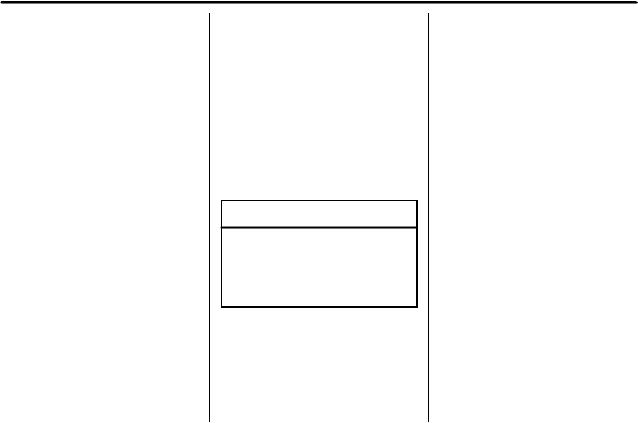
28 Keys, Doors, and Windows
Programming without a
Recognized Transmitter
Program a new key to the vehicle when a recognized key is not available. Canadian regulations require that owners see their dealer.
If there are no currently recognized keys available, follow this procedure to program the first key.
This procedure will take approximately 30 minutes to complete for the first key. The vehicle must be off and all of the keys you wish to program must be with you.
1.Insert the new vehicle key into the ignition.
2.Turn to ON/RUN. The security light will come on.
3.Wait 10 minutes until the security light turns off.
4.Turn the ignition to LOCK/OFF.
5.Repeat Steps 2–4 two more times. After the third time, turn to ON/RUN; the key is learned
and all previously known keys will no longer work with the vehicle.
Remaining keys can be learned by following the procedure in “Programming with a Recognized Transmitter.”
Battery Replacement
Replace the battery if the REPLACE BATTERY IN REMOTE KEY message displays in the DIC. See
Key and Lock Messages 0 119.
Caution
When replacing the battery, do not touch any of the circuitry on the transmitter. Static from your body could damage the transmitter.
The battery is not rechargeable. To replace the battery:
1.Press the button on the transmitter to extend the key.
2.Remove the battery cover by prying with a finger.
3.Remove the battery by pushing on the battery and sliding it toward the key blade.
4.Insert the new battery, positive side facing up. Push the battery down until it is held in place. Replace with a CR2032 or equivalent battery.
5.Snap the battery cover back on to the transmitter.
Remote Vehicle Start
The vehicle may have this feature that allows you to start the engine from outside the vehicle.
/ : This button will be on the RKE transmitter if the vehicle has remote start.
The climate control system will use the previous settings during a remote start. The rear defog may come on during remote start based on cold ambient conditions. The rear defog indicator light does not come on during remote start.
If the vehicle has heated seats, they may come on during a remote start. See Heated Front Seats 0 51.

Keys, Doors, and Windows 29
Laws in some local communities may restrict the use of remote starters. For example, some laws require a person using remote start to have the vehicle in view. Check local regulations for any requirements.
Other conditions can affect the performance of the transmitter. See
Remote Keyless Entry (RKE) System 0 26.
Starting the Engine Using Remote
Start
To start the engine using the remote start feature:
1.Press and release Q on the RKE transmitter.
2.Immediately press and hold / for at least four seconds or until the turn signal lamps flash. The turn signal lamps flashing confirms the request to remote start the vehicle has been received.
The parking lamps will turn on and remain on as long as the engine is running. The vehicle's doors will be locked.
3.The key must be inserted and turned to ON/RUN before driving.
The engine will shut off after 10 minutes unless a time extension is done or the key is inserted and turned to ON/RUN.
Extending Engine Run Time
For a 10-minute extension, after 30 seconds repeat Steps 1 and 2
while the engine is still running. The remote start can be extended once.
When the remote start is extended, the second 10 minutes will start immediately.
For example, if the engine has been running for five minutes, and
10 minutes are added, the engine will run for a total of 15 minutes.
A maximum of two remote starts or a start with an extension are allowed between ignition cycles.
The vehicle's ignition switch must be turned to ON/RUN and then back to LOCK/OFF using the key, before the remote start procedure can be used again.
Canceling a Remote Start
To shut off the engine:
.Press and hold / until the parking lamps turn off.
.Turn on the hazard warning flashers.
.Insert the key and turn it ON/ RUN and then back to LOCK/OFF.
Conditions in Which Remote Start
Will Not Work
The remote vehicle start feature will not operate if:
.The key is in the ignition.
.The hood is not closed.
.The hazard warning flashers are on.
.There is an emission control system malfunction.
